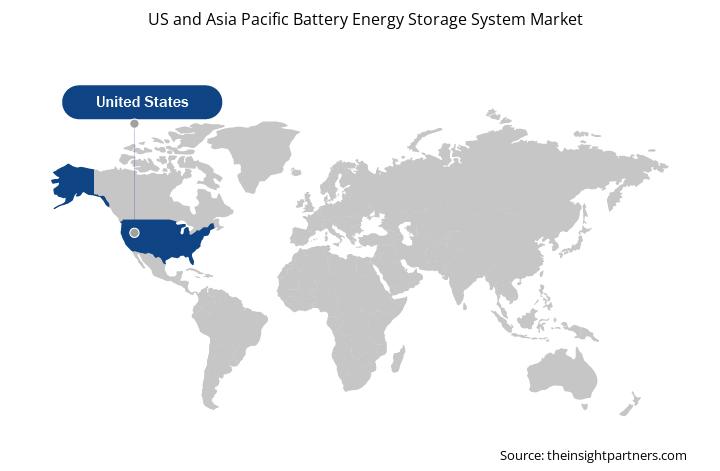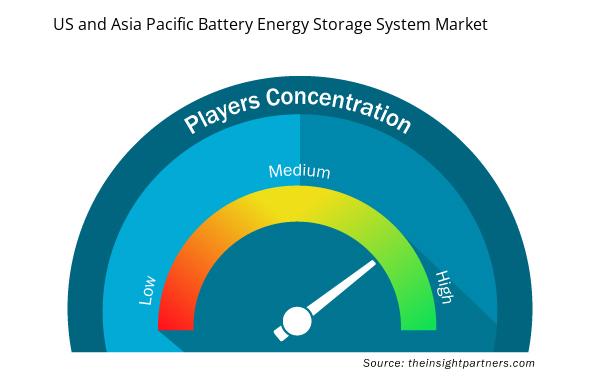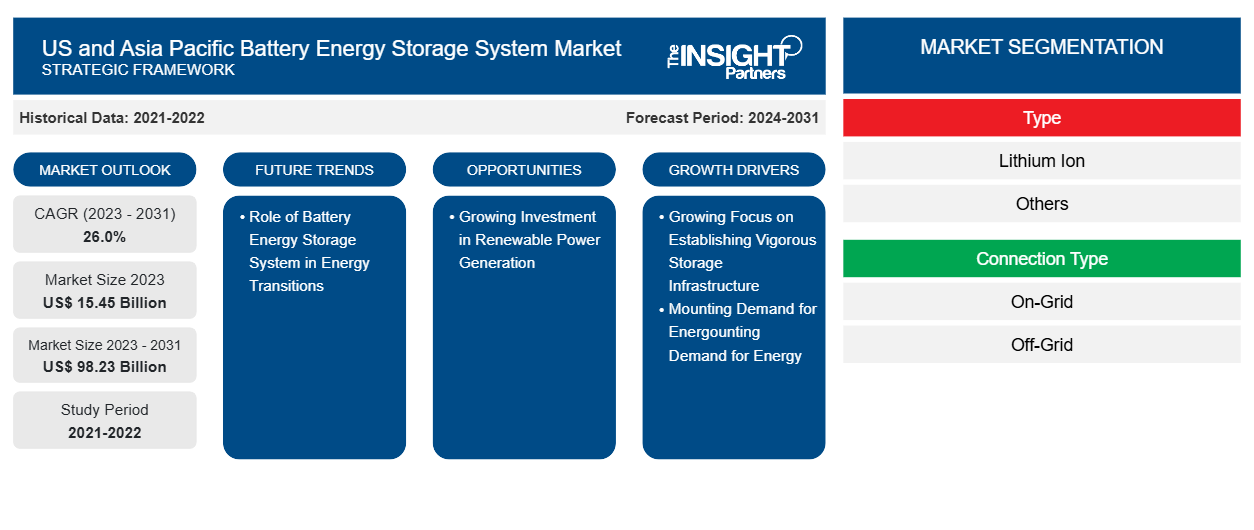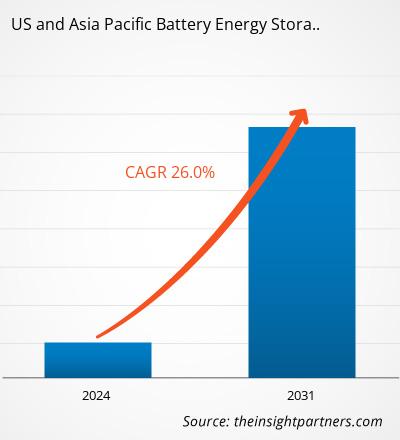电池储能系统市场规模预计将从 2023 年的 154.5 亿美元增至 2031 年的 982.3 亿美元。预计 2023-2031 年期间,该市场的复合年增长率将达到 26.0%。电池储能系统在能源转型中的作用可能会在未来几年为市场带来新的关键趋势。
电池储能系统市场分析
可再生能源行业的快速增长、对电池储能系统的需求激增以及政府对公用事业可再生能源项目的资助增加是推动美国和亚太地区电池储能系统市场增长的关键因素。此外,在预测期内,可再生能源发电投资的不断增长预计将为美国和亚太地区电池储能系统市场的主要公司创造丰厚的机会。此外,预计电池储能系统在能源转型中的作用将成为 2023 年至 2031 年市场未来的一个关键趋势。
能源生产商、输电系统运营商、存储提供商和最终用户是参与电池储能系统生态系统的利益相关者。各种来源,包括天然气、化石燃料和可再生能源(风能和太阳能),都用于产生能源。发电之后是输电和存储过程。储能过程涉及大型设施和分布式电源或储能系统。最后一步是将存储的能源分配给最终用户或主要应用领域。电池储能系统市场的最终用户是发电厂、商业、住宅和公用事业部门。
电池储能系统市场概览
电池储能系统 (BESS) 增强了电网的弹性和可靠性。此外,该系统通过套利降低了电力成本,通过提供备用电源降低了限电风险。这些好处吸引了美国和亚太地区的开发商和政府,特别是中国、印度、日本和韩国,将更多精力放在电池储能基础设施上。各州政府越来越多地鼓励将储能与太阳能相结合。此外,《通货膨胀削减法案》 (IRA) 为安装太阳能加储能系统和独立电池储能系统提供税收抵免,这推动了美国电池储能系统市场的增长。同样,印度政府于 2021 年 5 月推出了先进化学电池生产挂钩激励计划,旨在减少对进口电池的依赖并促进该国的工业发展。该计划旨在通过财政激励措施提高印度在储能领域的制造能力。为了建立合理的电池存储系统,印度政府已批准可行性缺口融资 (VGF) 计划,用于在 2023 年建立 4,000 MWh 的电池储能系统。该计划为 VGF 提供的资金最高可达 BESS 资本支出的约 40%,这将降低 BESS 的电力成本。
定制此报告以满足您的需求
您可以免费定制任何报告,包括本报告的部分内容、国家级分析、Excel 数据包,以及为初创企业和大学提供优惠和折扣
- 获取此报告的关键市场趋势。这个免费样品将包括数据分析,从市场趋势到估计和预测。
电池储能系统市场驱动因素和机遇
能源需求不断增长
人口增长和城市化进程加快是推动美国和亚太地区能源使用的一些关键因素。根据美国能源信息署 (EIA) 的数据,由于经济和人口增长,预计到 2050 年美国的能源消耗将增长。EIA 还报告称,2022 年美国电力终端消费量比 2021 年高出约 3.2%。电池储能具有在危机时期或偏远地区(没有电网)用作储能的潜在应用。此外,由于全球能源不确定性增加,美国政府正在推动电池储能的应用。例如,Plus Power 于 2024 年 5 月从摩根士丹利银行获得了 8200 万美元的税收股权投资,用于位于亚利桑那州的 90 MW/360 MWh Superstition BESS 项目,预计该项目将于 2024 年 6 月投入运营。此外,RWE 于 2024 年 2 月在德克萨斯州和亚利桑那州完成了三个新电池储能系统 (BESS) 的建设,总计 190 MW(361 MWh)。
亚太地区一些农村国家(如印度和印度尼西亚)对电池储能系统的需求很高,这些国家/地区的电力供应充足仍然是当局面临的挑战。这些国家的政府一直在推动安装电池储能系统 (BESS),这是一种紧急情况下的可靠电源。例如,在 2024 年第一季度,恰蒂斯加尔邦(印度中部的一个农村邦)占该国 2024 年投入使用的 BESS 累计容量的约 55%。因此,不断增长的能源需求推动了美国和亚太地区电池储能系统市场的发展。
可再生能源发电投资不断增长
美国政府正致力于减少其碳足迹,因此能源行业正在见证向清洁能源的转型。因此,政府正在加大对绿色能源生产的投资。使用化石燃料发电是导致气候变化的温室气体 (GHG) 排放的主要原因。由于对使用清洁和绿色能源的关注度不断提高、对气候变化的担忧日益加剧以及政府越来越多地鼓励在美国各地使用可再生能源的举措,太阳能和风能的利用率正在增加。到 2030 年,美国政府的目标是将净温室气体排放量与 2005 年的水平相比减少约 50-52%,到 2050 年实现净零排放。因此,对温室气体排放的日益担忧正在推动对可再生能源发电的投资,预计这将为预测期内电池储能系统市场的发展提供有利可图的机会。
电池储能系统市场报告细分分析
促成美国和亚太地区电池储能系统市场分析的关键部分包括:类型、连接类型和最终用户。
- 就类型而言,美国和亚太地区的电池储能系统市场分为锂离子和其他类型。锂离子电池在 2023 年占据了更大的市场份额。
- 根据连接类型,美国和亚太地区的电池储能系统市场分为并网和离网。2023 年,并网部分占据了市场主导地位。
- 根据最终用户,美国和亚太地区的电池储能系统市场分为商业、公用事业和住宅。公用事业部门在 2023 年占据了最大的电池储能系统市场份额。
电池储能系统市场份额(按地区)分析
电池储能系统市场报告的地理范围提供了美国和亚太地区的详细国家分析。由于政府对可再生能源发电的举措和投资增加,以及微电网和电池储能系统 (BESS) 容量的扩大,美国和中国是电池储能系统市场显着增长的主要国家。人们对采用可再生能源的认识不断提高,对太阳能和风能项目的投资不断增加,推动了美国对储能用锂离子电池的需求。2023 年,美国可再生能源安装量与 2021 年相比增长了约 37%,与 2022 年相比增长了 51%。
预计在停电或电网接入受限期间对备用电源的需求增加将推动该国对 BESS 的需求。此外,为确保稳定可靠的电力供应,美国各地微电网和离网系统中电池储能系统 (BESS) 的使用增加预计将在 2023-2031 年期间推动电池储能系统市场的增长。此外,全国范围内对太阳能和风能项目开发的投资和举措的增加预计将在未来几年推动电池储能系统市场的增长。2023 年,德克萨斯州在该地区安装了约 6,500 兆瓦的太阳能系统,超过加利福尼亚州,成为美国可再生能源安装量最大的州。
电池储能系统市场报告覆盖范围和交付成果
“电池储能系统市场规模和预测(2021-2031 年)”报告对以下领域进行了详细的市场分析:
- 范围内所有主要细分市场的电池储能系统市场规模及国家层面预测
- 电池储能系统市场趋势,以及驱动因素、限制因素和关键机遇等市场动态
- 详细的 PEST 和 SWOT 分析
- 电池储能系统市场分析涵盖主要市场趋势、国家框架、主要参与者、法规和最新市场发展
- 行业格局和竞争分析,涵盖市场集中度、热图分析、知名参与者以及电池储能系统市场的最新发展
- 详细的公司简介
报告范围
美国和亚太电池储能系统市场区域洞察
Insight Partners 的分析师已详尽解释了预测期内影响美国和亚太地区电池储能系统市场的区域趋势和因素。本节还讨论了美国和亚太地区电池储能系统市场的各个部分以及北美、欧洲、亚太地区、中东和非洲以及南美和中美洲的地理位置。

- 获取美国和亚太电池储能系统市场的区域特定数据
美国和亚太电池储能系统市场报告范围
| 报告属性 | 细节 |
|---|---|
| 2023 年的市场规模 | 154.5亿美元 |
| 2031 年市场规模 | 982.3亿美元 |
| 全球复合年增长率(2023 - 2031) | 26.0% |
| 史料 | 2021-2022 |
| 预测期 | 2024-2031 |
| 涵盖的领域 | 按类型
|
| 覆盖地区和国家 | 美国、亚太地区
|
| 市场领导者和主要公司简介 |
|
美国和亚太地区电池储能系统市场参与者密度:了解其对业务动态的影响
美国和亚太地区的电池储能系统市场正在快速增长,这得益于终端用户需求的不断增长,这些需求源于消费者偏好的不断变化、技术进步以及对产品优势的认识不断提高等因素。随着需求的增加,企业正在扩大其产品范围,进行创新以满足消费者的需求,并利用新兴趋势,从而进一步推动市场增长。
市场参与者密度是指在特定市场或行业内运营的企业或公司的分布情况。它表明在给定市场空间中,相对于其规模或总市场价值,有多少竞争对手(市场参与者)存在。
在美国和亚太电池储能系统市场运营的主要公司有:
- 比亚迪股份有限公司
- 安全美国公司
- 宁德时代
- 特斯拉公司
- 三星SDI有限公司
- 松下控股公司
免责声明:上面列出的公司没有按照任何特定顺序排列。

- 了解美国和亚太地区电池储能系统市场顶级关键参与者概况
- 历史分析(2 年)、基准年、预测(7 年)及复合年增长率
- PEST 和 SWOT 分析
- 市场规模价值/数量 - 全球、区域、国家
- 行业和竞争格局
- Excel 数据集



Report Coverage
Revenue forecast, Company Analysis, Industry landscape, Growth factors, and Trends

Segment Covered
This text is related
to segments covered.

Regional Scope
North America, Europe, Asia Pacific, Middle East & Africa, South & Central America

Country Scope
This text is related
to country scope.
常见问题
The US & APAC battery energy storage system market is expected to reach US$ 98.23 billion by 2031.
Growing Focus on Establishing Vigorous Storage Infrastructure; and Mounting Demand for Energy are some of the major drivers of the US & APAC battery energy storage system market.
India is anticipated to grow at the fastest CAGR over the forecast period.
The key players operating in the US & APAC battery energy storage system market include BYD Co. Ltd; Samsung SDI Co Ltd; Panasonic Holdings Corp; Contemporary Amperex Technology Co Ltd; Tesla Inc; AES Corp; Ameresco Inc; Siemens AG; KORE Power Inc; General Electric Co; NextEra Energy Inc; Eos Energy Enterprises Inc; Saft Groupe SA; LG Chem Ltd; and ESS Inc.
The lithium-ion segment led the battery energy storage system market with a significant share in 2023.
The battery energy storage system market was valued at US$ 15.45 billion in 2023; it is expected to register a CAGR of 26.0% during 2023–2031.
Role of battery energy storage system in energy transitions is expected to drive the growth of the US & APAC battery energy storage system market in the coming years.
Trends and growth analysis reports related to Energy and Power : READ MORE..
The List of Companies - US and Asia Pacific Battery Energy Storage System Market
- BYD Co. Ltd
- Samsung SDI Co Ltd
- Panasonic Holdings Corp
- Contemporary Amperex Technology Co Ltd
- Tesla Inc
- AES Corp
- Ameresco Inc
- Siemens AG
- KORE Power Inc
- General Electric Co
- NextEra Energy Inc
- Eos Energy Enterprises Inc
- Saft Groupe SA
- LG Chem Ltd
- ESS Inc
The Insight Partners performs research in 4 major stages: Data Collection & Secondary Research, Primary Research, Data Analysis and Data Triangulation & Final Review.
- Data Collection and Secondary Research:
As a market research and consulting firm operating from a decade, we have published and advised several client across the globe. First step for any study will start with an assessment of currently available data and insights from existing reports. Further, historical and current market information is collected from Investor Presentations, Annual Reports, SEC Filings, etc., and other information related to company’s performance and market positioning are gathered from Paid Databases (Factiva, Hoovers, and Reuters) and various other publications available in public domain.
Several associations trade associates, technical forums, institutes, societies and organization are accessed to gain technical as well as market related insights through their publications such as research papers, blogs and press releases related to the studies are referred to get cues about the market. Further, white papers, journals, magazines, and other news articles published in last 3 years are scrutinized and analyzed to understand the current market trends.
- Primary Research:
The primarily interview analysis comprise of data obtained from industry participants interview and answers to survey questions gathered by in-house primary team.
For primary research, interviews are conducted with industry experts/CEOs/Marketing Managers/VPs/Subject Matter Experts from both demand and supply side to get a 360-degree view of the market. The primary team conducts several interviews based on the complexity of the markets to understand the various market trends and dynamics which makes research more credible and precise.
A typical research interview fulfils the following functions:
- Provides first-hand information on the market size, market trends, growth trends, competitive landscape, and outlook
- Validates and strengthens in-house secondary research findings
- Develops the analysis team’s expertise and market understanding
Primary research involves email interactions and telephone interviews for each market, category, segment, and sub-segment across geographies. The participants who typically take part in such a process include, but are not limited to:
- Industry participants: VPs, business development managers, market intelligence managers and national sales managers
- Outside experts: Valuation experts, research analysts and key opinion leaders specializing in the electronics and semiconductor industry.
Below is the breakup of our primary respondents by company, designation, and region:

Once we receive the confirmation from primary research sources or primary respondents, we finalize the base year market estimation and forecast the data as per the macroeconomic and microeconomic factors assessed during data collection.
- Data Analysis:
Once data is validated through both secondary as well as primary respondents, we finalize the market estimations by hypothesis formulation and factor analysis at regional and country level.
- Macro-Economic Factor Analysis:
We analyse macroeconomic indicators such the gross domestic product (GDP), increase in the demand for goods and services across industries, technological advancement, regional economic growth, governmental policies, the influence of COVID-19, PEST analysis, and other aspects. This analysis aids in setting benchmarks for various nations/regions and approximating market splits. Additionally, the general trend of the aforementioned components aid in determining the market's development possibilities.
- Country Level Data:
Various factors that are especially aligned to the country are taken into account to determine the market size for a certain area and country, including the presence of vendors, such as headquarters and offices, the country's GDP, demand patterns, and industry growth. To comprehend the market dynamics for the nation, a number of growth variables, inhibitors, application areas, and current market trends are researched. The aforementioned elements aid in determining the country's overall market's growth potential.
- Company Profile:
The “Table of Contents” is formulated by listing and analyzing more than 25 - 30 companies operating in the market ecosystem across geographies. However, we profile only 10 companies as a standard practice in our syndicate reports. These 10 companies comprise leading, emerging, and regional players. Nonetheless, our analysis is not restricted to the 10 listed companies, we also analyze other companies present in the market to develop a holistic view and understand the prevailing trends. The “Company Profiles” section in the report covers key facts, business description, products & services, financial information, SWOT analysis, and key developments. The financial information presented is extracted from the annual reports and official documents of the publicly listed companies. Upon collecting the information for the sections of respective companies, we verify them via various primary sources and then compile the data in respective company profiles. The company level information helps us in deriving the base number as well as in forecasting the market size.
- Developing Base Number:
Aggregation of sales statistics (2020-2022) and macro-economic factor, and other secondary and primary research insights are utilized to arrive at base number and related market shares for 2022. The data gaps are identified in this step and relevant market data is analyzed, collected from paid primary interviews or databases. On finalizing the base year market size, forecasts are developed on the basis of macro-economic, industry and market growth factors and company level analysis.
- Data Triangulation and Final Review:
The market findings and base year market size calculations are validated from supply as well as demand side. Demand side validations are based on macro-economic factor analysis and benchmarks for respective regions and countries. In case of supply side validations, revenues of major companies are estimated (in case not available) based on industry benchmark, approximate number of employees, product portfolio, and primary interviews revenues are gathered. Further revenue from target product/service segment is assessed to avoid overshooting of market statistics. In case of heavy deviations between supply and demand side values, all thes steps are repeated to achieve synchronization.
We follow an iterative model, wherein we share our research findings with Subject Matter Experts (SME’s) and Key Opinion Leaders (KOLs) until consensus view of the market is not formulated – this model negates any drastic deviation in the opinions of experts. Only validated and universally acceptable research findings are quoted in our reports.
We have important check points that we use to validate our research findings – which we call – data triangulation, where we validate the information, we generate from secondary sources with primary interviews and then we re-validate with our internal data bases and Subject matter experts. This comprehensive model enables us to deliver high quality, reliable data in shortest possible time.


 获取此报告的免费样本
获取此报告的免费样本